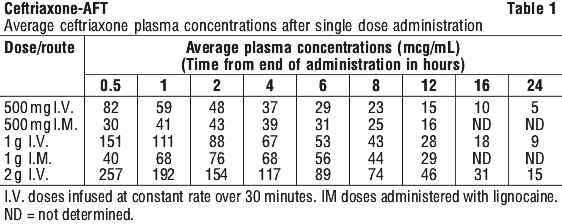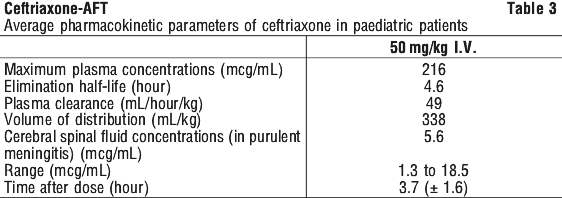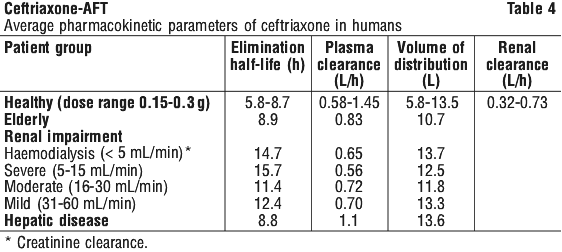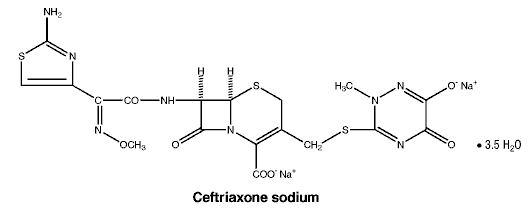SUMMARY CMI
Ceftriaxone-AFT
Consumer Medicine Information (CMI) summary
The full CMI on the next page has more details. If you are worried about using this medicine, speak to your doctor or pharmacist.
1. Why am I given Ceftriaxone-AFT?
Ceftriaxone-AFT contains the active ingredient ceftriaxone sodium. Ceftriaxone-AFT is an antibiotic used to treat infections in different parts of the body caused by bacteria. For more information, see Section 1. Why am I given Ceftriaxone-AFT? in the full CMI.
2. What should I know before I am given Ceftriaxone-AFT?
You should not be given Ceftriaxone-AFT if you have ever had an allergic reaction to ceftriaxone sodium or penicillin.
Talk to your doctor if you have any other medical conditions, take any other medicines, or are pregnant or plan to become pregnant or are breastfeeding.
For more information, see Section 2. What should I know before I am given Ceftriaxone-AFT? in the full CMI.
3. What if I am taking other medicines?
Some medicines and Ceftriaxone-AFT may interfere with each other.
A list of these medicines is in Section 3. What if I am taking other medicines? in the full CMI.
4. How Ceftriaxone-AFT is Given?
Ceftriaxone-AFT will be given by either a doctor or nurse. It can be given either as a slow injection into a vein or as an injection into a large muscle. More instructions can be found in Section 4. How Ceftriaxone-AFT is given? in the full CMI.
5. What should I know while I am given Ceftriaxone-AFT?
| Things you should do |
|
| Things you should not do |
|
| Driving or using machines |
|
For more information, see Section 5. What should I know while using Ceftriaxone-AFT? in the full CMI.
6. Are there any side effects?
Like all medicines, Ceftriaxone-AFT can cause side effects. Sometimes they are serious, most of the time they are not. You may need medical treatment if you get some of the side effects. For more information, including what to do if you have any side effects, see Section 6. Are there any side effects? in the full CMI.
FULL CMI
Ceftriaxone-AFT
Active ingredient(s): Ceftriaxone sodium
Consumer Medicine Information (CMI)
This leaflet provides important information about using Ceftriaxone-AFT. You should also speak to your doctor or pharmacist if you would like further information or if you have any concerns or questions about using Ceftriaxone-AFT.
Where to find information in this leaflet:
1. Why am I given Ceftriaxone-AFT?
2. What should I know before I am given Ceftriaxone-AFT?
3. What if I am taking other medicines?
4. How Ceftriaxone-AFT is Given?
5. What should I know while I am given Ceftriaxone-AFT?
6. Are there any side effects?
7. Product details
1. Why am I given Ceftriaxone-AFT?
Ceftriaxone-AFT contains the active ingredient ceftriaxone sodium. Ceftriaxone-AFT is an antibiotic used to treat infections in different parts of the body caused by bacteria. Ceftriaxone-AFT is also used to prevent infections before, during and after surgery. It will not work against infections caused by viruses such as colds and flus.
Ceftriaxone-AFT belongs to a group of antibiotics called cephalosporins. They work by killing the bacteria that are causing your infection or by stopping the bacteria from growing.
If you are not sure why Ceftriaxone-AFT has been prescribed for you, talk to your doctor. They may have prescribed it for another reason.
2. What should I know before I am given Ceftriaxone-AFT?
Warnings
You should not be given Ceftriaxone-AFT if:
- you are allergic to ceftriaxone sodium, or any of the ingredients listed at the end of this leaflet.
- have had an allergic reaction to any penicillin.
Symptoms of allergic reactions include severe skin rash, itching, hives, dry skin, swelling of the face, lips, mouth, throat which may cause difficulty in swallowing or breathing, swelling of the hands, feet or ankles.
You may have an increased risk of being allergic to Ceftriaxone-AFT if you are allergic to penicillin.
Always check the ingredients to make sure you can use this medicine.
Ceftriaxone-AFT should not be given to newborn infants if they need or are expected to need treatment with calcium containing intravenous solutions including intravenous nutrition.
Ceftriaxone-AFT should not be given to preterm newborns or newborns with certain liver disorders.
If you are uncertain if Ceftriaxone-AFT should be given to you, talk to your doctor.
Check with your doctor if you:
- have had any type of allergic reaction to any cephalosporin or penicillin medicines.
- have had an allergy or over-reaction to lignocaine or other anesthetic medicines (these substances may be used to dissolve Ceftriaxone-AFT before administration).
- have any allergies to any other medicines or other substances e.g., foods, preservatives, dyes.
- have any other medical conditions including kidney disease, bowel problems (e.g., inflammation of the large bowel), diarrhea associated with previous use of antibiotics or a previous intestinal infection with a bacteria called Clostridium difficile.
If you have not told your doctor about any of the above, you must tell them before you are given Ceftriaxone-AFT.
During treatment, you may be at risk of developing certain side effects. It is important you understand these risks and how to monitor them. See additional information under Section 6. Are there any side effects?
Pregnancy and breastfeeding
Check with your doctor if you are pregnant or intend to become pregnant.
Talk to your doctor if you are breastfeeding or intend to breastfeed.
3. What if I am taking other medicines?
Tell your doctor or pharmacist if you are taking any other medicines, including any medicines, vitamins, or supplements that you buy without a prescription from your pharmacy, supermarket or health food shop.
Some medicines and Ceftriaxone-AFT may interfere with each other. These include:
- chloramphenicol, vancomycin, aminoglycosides (medicines to treat infections),
- fluconazole (a medicine used to treat fungal infections)
- amsacrine (a medicine used to treat cancer).
These medicines may be affected by Ceftriaxone-AFT or may affect how well it works. You may need to take different amounts of your medicines. Your doctor will advise you.
Some antibiotics decrease the effectiveness of some contraceptive pills. Talk to your doctor about the need for additional contraception while using Ceftriaxone-AFT.
Your doctor or pharmacist will have more information on medicines to be careful with or avoid while being given Ceftriaxone-AFT.
Check with your doctor or pharmacist if you are not sure about what medicines, vitamins or supplements you are taking and if these affects Ceftriaxone-AFT.
4. How Ceftriaxone-AFT is Given?
Ceftriaxone-AFT will be given by either a doctor or nurse.
Ceftriaxone-AFT can be given as either:
- As a slow injection into a vein
- As an injection into a large muscle
Ceftriaxone-AFT should not be mixed or administered with calcium-containing solutions even via different infusion lines.
Your doctor will decide what dose and for how long you will receive Ceftriaxone-AFT. It will depend on your infection and other factors such as your weight. For most infections Ceftriaxone-AFT is usually given once a day. The length of treatments is usually 4-14 days.
Sometimes only a single dose of Ceftriaxone-AFT is required for the treatment and prevention of certain infections.
If you are given too much Ceftriaxone-AFT
If too much Ceftriaxone-AFT is given to you, you may experience symptoms such as tingling or skin reactions, chills, diarrhea, stomach upsets, headache or dizziness.
If you think that you have been given too much Ceftriaxone-AFT, you may need urgent medical attention.
You should immediately:
- phone the Poisons Information Centre
(by calling 13 11 26), or - contact your doctor, or
- go to the Emergency Department at your nearest hospital.
You should do this even if there are no signs of discomfort or poisoning.
5. What should I know while I am given Ceftriaxone-AFT?
If the symptoms of your infection do not improve within a few days or if they become worse, tell your doctor.
If you get severe diarrhea, tell your doctor, nurse or pharmacist immediately even if occurs several weeks after Ceftriaxone-AFT has been stopped. Diarrhea may mean you have a serious condition affecting your bowel. You may need urgent medical attention. Do not take any medicine to stop the diarrhea without first checking with your doctor.
Tell your doctor if you get a sore or white furry mouth or tongue or if you get vaginal itching or discharge. You may have a fungal infection called thrush. Sometimes the use of Ceftriaxone-AFT may allow fungi to grow and the above symptoms to occur. Ceftriaxone-AFT will not work against fungi.
Tell your doctor if you become pregnant while using Ceftriaxone-AFT.
If you test your urine for sugar, make sure your doctor knows which type of test you use as Ceftriaxone-AFT may affect the test results.
If you are having any blood tests tell whoever is doing the tests that you are taking Ceftriaxone-AFT as Ceftriaxone-AFT may affect the results of some blood tests.
Complete blood counts should be done at regular intervals as Ceftriaxone-AFT may affect the results of some blood tests.
Tell all doctors, dentists and pharmacists who are treating you that you are using Ceftriaxone-AFT.
Driving or using machines
Be careful before you drive or use any machines or tools until you know how Ceftriaxone-AFT affects you.
Ceftriaxone-AFT generally does not cause any problems with your ability to drive or operate machinery. However, Ceftriaxone-AFT may cause dizziness in some people.
Looking after your medicine
Ceftriaxone-AFT will be stored in the pharmacy or on the hospital ward. It should be kept in a cool, dry place, protected from light and moisture at a temperature below 25°C.
6. Are there any side effects?
All medicines can have side effects. If you do experience any side effects, most of them are minor and temporary. However, some side effects may need medical attention.
See the information below and, if you need to, ask your doctor or pharmacist if you have any further questions.
Less serious/common side effects
| Less serious side effects | What to do |
| Speak to your doctor or pharmacist if you have any of these less serious side effects and they worry you. |
Serious/rare side effects
| Serious side effects | What to do |
Allergic reaction
| Call your doctor straight away or go straight to the Emergency Department at your nearest hospital if you notice any of these serious side effects. |
*Tell your doctor immediately even if these side effects occur even if it is several weeks after stopping treatment with Ceftriaxone-AFT. You may have a serious condition affecting your bowel. Do not take any medicine to stop the diarrhea without first checking with your doctor.
Treatment with ceftriaxone, particularly in elderly patients with serious kidney or nervous system problems may rarely cause decreased consciousness, abnormal movements, agitation, and convulsions.
Tell your doctor or pharmacist if you notice anything else that may be making you feel unwell.
Other side effects not listed here may occur in some people.
Reporting side effects
After you have received medical advice for any side effects you experience, you can report side effects to the Therapeutic Goods Administration online at www.tga.gov.au/reporting-problems. By reporting side effects, you can help provide more information on the safety of this medicine.
7. Product details
This medicine is only available with a doctor's prescription.
What Ceftriaxone-AFT contains
| Active ingredient (main ingredient) | Ceftriaxone sodium |
| Other ingredients (inactive ingredients) | This product does not contain any other ingredients |
Do not take this medicine if you are allergic to ceftriaxone sodium.
What Ceftriaxone-AFT looks like
Ceftriaxone-AFT is a white to yellowish powder. It is supplied in a glass vial containing 500 mg (AUST R 185099), 1 g (AUST R 185100) or 2 g (AUST R 185101) ceftriaxone sodium. The powder is dissolved before injection into a vein or muscle.
Who distributes Ceftriaxone-AFT
AFT Pharmaceuticals Pty Ltd
113 Wicks Road North Ryde
NSW 2113
This leaflet was prepared in January 2024.
Published by MIMS March 2024

 Mean maximum plasma concentrations following I.M. injection occurred 2-3 hours postdosing. Multiple I.M. and I.V. doses ranging between 500 mg-2 g at 12-24 hourly intervals resulted in 15-36% accumulation of ceftriaxone above single dose results. Accumulation was greater with I.M. doses.
Mean maximum plasma concentrations following I.M. injection occurred 2-3 hours postdosing. Multiple I.M. and I.V. doses ranging between 500 mg-2 g at 12-24 hourly intervals resulted in 15-36% accumulation of ceftriaxone above single dose results. Accumulation was greater with I.M. doses. Over a 0.15 to 3 g dose range in healthy adult subjects, the values of elimination half-life ranged from 5.8 to 8.7 hours, apparent volume of distribution from 5.78 to 13.5 L; plasma clearance from 0.58 to 1.45 L/hr and renal clearance from 0.32 to 0.73 L/hr. Ceftriaxone is reversibly bound to human plasma proteins, and the binding decreased from a value of 95% bound at plasma concentrations of 25 microgram/mL to a value of 85% bound at 300 microgram/mL. Protein binding is reduced in children and in uremic patients. The in vitro activity of ceftriaxone is decreased 2 to 8-fold by the presence of human serum.
Over a 0.15 to 3 g dose range in healthy adult subjects, the values of elimination half-life ranged from 5.8 to 8.7 hours, apparent volume of distribution from 5.78 to 13.5 L; plasma clearance from 0.58 to 1.45 L/hr and renal clearance from 0.32 to 0.73 L/hr. Ceftriaxone is reversibly bound to human plasma proteins, and the binding decreased from a value of 95% bound at plasma concentrations of 25 microgram/mL to a value of 85% bound at 300 microgram/mL. Protein binding is reduced in children and in uremic patients. The in vitro activity of ceftriaxone is decreased 2 to 8-fold by the presence of human serum. The half-life of ceftriaxone in neonates ranges from 7.2-19 hours and in infants over six weeks of age from 4.0-6.6 hours.
The half-life of ceftriaxone in neonates ranges from 7.2-19 hours and in infants over six weeks of age from 4.0-6.6 hours.
 It has the chemical formula C18H16N8Na2O7S3, 3.5 H2O with a molecular weight of 661.6.
It has the chemical formula C18H16N8Na2O7S3, 3.5 H2O with a molecular weight of 661.6.